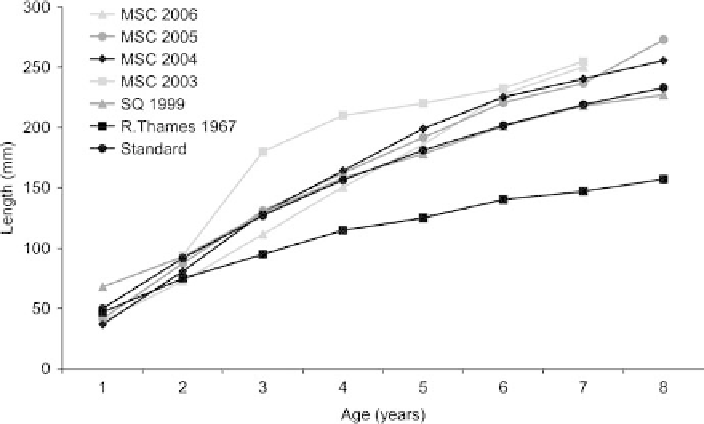Environmental Engineering Reference
In-Depth Information
Figure 14.12.
Growth rates for roach in the MSC, Salford Quays and the River Thames
(after Williams
1967
). Also shown is the Hickley Growth Standard Curve.
during winter months revealed shoals to be present throughout the Turning
Basin. It seems likely that, during the winter months, fish may favour such
areas in order to take advantage of the reduced flows as a way of maximising
bioenergetic efficiency. During May however very few fish were recorded in
the Turning Basin during the day, and it was suggested that the aggregation of
spawning adults in this section of the MSC relocate to habitats upstream of the
survey reach (i.e., the feeder streams) to spawn during the day. The free passage
to the lower River Irwell provides greatly enhanced spawning and feeding
potential due to increased habitat complexity available in the lower river.
The fish retreated into the MSC overnight suggesting that selection of this area
was due to the maintenance of oxygen levels through oxygenation, as it is
unlikely to be for flow avoidance as flows would be relatively low in all
stretches of the lower river at this time of year.
Ameasure of fish condition is provided by Fulton's Condition Factor (K
W/L
3
,
where W is weight and L is length) (Fulton
1911
). The formula is based on the
assumption that for a given length a heavier fish is in better condition (e.g.,
Bagenal & Tesch
1978
). Average figures for roach and perch from the MSC
in 2006 were 1.61 and 1.57, respectively, being comparable to recent figures
obtained from the adjacent clean waters of Salford Quays (1.70 and 1.53) and
thus indicating that the fish were in very good condition (APEM
2006b
). Growth
curves of MSC roach captured in 2006 followed the expected trend of rapid
growth in younger fish, with growth becoming slower in adults (
Fig. 14.12
).
Back-calculation revealed that fish at age 1
¼
þ
were very similar in size to those

